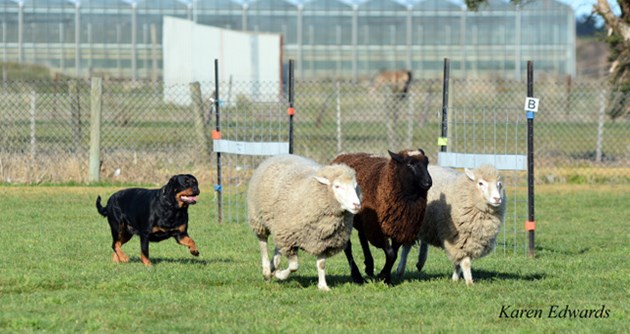Herding
Background
When the early settlers arrived at what became Australia, they brought with them their ways of using the land to provide sustenance, this included livestock and the dogs they had used to guard and herd this stock. Working dogs quickly became part of the backbone of the developing nation, of which is was said for many years that Australia rode on the sheep’s back.
In the early 1990’s, Australia wide, people who owned dogs not in work but of the herding breeds were keen to demonstrate that their dogs, some bred for many generations purely for showing or performance activities, were still able to perform the functions for which they were developed in the first place.
In Victoria this charge was led by keen members of the Working Dog Club of Victoria Inc, an affiliate of what is now Dogs Victoria, which in turn is a member of the national body, Dogs Australia (ANKC Ltd). A lot of hard work was put in by these “pioneers” of what is now a burgeoning activity across most of the country, ANKC Herding, which commenced officially in January, 2001.
Who can compete?
Under ANKC rules, dogs in Australia are placed into groups according to their function and the herding and flock guarding breeds are found in group five. Any of these dogs may compete in herding activities. Currently group five breeds are:
| Australian Cattle Dog | Australian Kelpie | Australian Shepherd | Australian Stumpy Tail Cattle Dog |
| Bearded Collie | Belgian Shepherd (all varieties) | Bergamasco Shepherd Dog | Border Collie |
| Bouvier Des Flandres | Briard | Collie (Rough) | Collie (Smooth) |
| Dutch Shepherd | Finnish Lapphund | German Shepherd Dog | Komondor |
| Kuvasz | Maremma Sheepdog | Norwegian Buhund | Old English Sheepdog |
| Polish Lowland Sheepdog | Puli | Pumi | Pyrenean Sheepdog Longhaired |
| Shetland Sheepdog | Swedish Lapphund | Welsh Corgi (Cardigan) | Welsh Corgi (Pembroke) |
| White Swiss Shepherd Dog |
Dogs of mixed breeds may compete providing they are a mix or apparent mix of herding breeds. These dogs must be associate registered dogs with the ANKC, through Dogs Victoria if in Victoria.
Also…
There are some breeds from other groups which are eligible to compete because they have a background of herding in their development, currently:
| Bernese Mountain Dog | Canaan Dog | Keeshond | Kerry Blue Terrier |
| Norwegian Elkhound | Schnauzer (Standard) | Schnauzer (Giant) | Soft Coated Wheaten Terrier |
| Rottweiler | Tibetan Terrier | Samoyed |
And finally…
Working dogs, which are dogs registered with a body recognised by the ANKC as an approved working dog registry. These approved bodies are listed on the ANKC website.
Not all of these breeds will be seen at a herding event because the function of some was not to herd, but to guard the flock from predators, often they lived with the flock, and they were not bred to want to work with a person, as the true herding breeds must do. If you read the breed standards on the ANKC website you should be able to find out what your dog was bred for. Breed standards are not just to describe what a breed should look like, they reflect a dog built for a purpose, in the case of the herding breeds a dog which should be able to put in long hours and often in rough terrain and to have strong desire to work with a human.
Different dogs…different jobs
Not all herding breeds did the same work, some worked vast areas, often well away from the handler, to gather and move stock, some drove stock to market or from one pasture to another or brought them in for milking, some acted as living fences and kept the flock in a grazing area by constantly patrolling the unfenced area according to the shepherd’s needs, some went out in all kinds of weather to check on stock and help the farmer find animals needing help, others worked in the yards to push stock through races, up ramps, into trucks or shearing sheds, so different breeds and even different strains of breeds were thus developed. Many breeds ended up multiskilled and able to help out wherever needed.
The ANKC rules reflect this and there are different herding trial courses at which the various breeds excel.
So what is herding all about?
The rules and regulations for herding are located on the ANKC website and can also be found here
These rules, as well as explaining the work required, have plans of each course available to be tested in.
How do you get started?
Several breed clubs in Victoria offer herding events over the year or have members who can help you with advice, so that is often a starting point. The Victorian Herding Association Inc is currently the only Dogs Victoria affiliated club dedicated to herding in Victoria. Check out their website at www.victorianherdingassociation.com
There are places offering private herding tuition and useful internet groups which will keep you abreast of things, especially when and where the next herding event is being held, you might like to go and have a look before jumping in.
Herding rules require that the dog has had some exposure to stock prior to entering, so exploring the avenues above will usually be the beginning for most dogs.
Sometimes a dog will need more than one exposure to stock to turn on the herding switch, be patient and try and have an experienced person with you under controlled circumstances to give your dog the confidence to bring out its instincts. Other dogs are over-keen and they too need careful handling to curb and direct the skills we need.
The welfare of stock is paramount at all times in herding, stock used in tests and trials are sheep, cattle or ducks.
What do you have to do?
There are various levels of tests and trials, right up to herding champion if you have the time, the opportunity and the right dog. But at any level there is something special about being part of the dog-human team doing what the dog was meant to do.
To enter a test or trial
The dog has to be registered with Dogs Victoria on one of these registers: main, limited, associate, or sporting, and the owner of the dog, plus the handler if they are not the owner, must be a financial member of Dogs Victoria or similar Australian state canine control.
Instinct test
All dogs must pass this test prior to moving on. This is performed in a small rounded area and the dog must show sustained interest in the stock whilst on a long lead, the lead may be dropped or removed at the discretion of the judge. The dog must be able to be called off the stock, come to its handler, and be able to be caught to pass. Only one pass is required to move up to the herding test.
Herding test
This is done off leash in a small area. The dog must be able to:
- hold a pause or stop at the beginning
- make two changes of direction around pylons which show controlled movement of the stock
- stop when told, and
- come to the handler at the end of the test
Two passes under two different judges are required to attain the herding tested certificate, the handler may do more tests for experience but two passes means you can move up to the next level.
Pre trial
This is in a larger area with the first real experience for the dog
- working the sheep through obstacles
- changing direction, and
- putting them in a pen at the end
The handler is not allowed to touch the stock but may give the dog a lot of help and the judge will also assist with advice if needed.
Two pre-trial passes under two different judges will give the dog it’s pre trial tested title.
Herding trials
Trials are conducted over three different Courses, A, B & C. Course A is a smaller area, Course B has more space and Course C is conducted over a larger area to test all the skills a dog might need to have in the daily management of stock. Some dogs or breeds are more suited to one course or another but a dog can compete in any or all.
Details of courses and what has to be achieved is in the ANKC Herding Rules as above.
Each course has three levels, started, intermediate and advanced, a dog requires three passes under two different judges to attain a title at each level as it moves up the ladder to the highly respected herding champion title.
To sum up
Herding is attracting many followers, it is an activity in which dog and handler can work together as man and dog have been doing for thousands of years. It might be just a taste but many people are out every weekend with like-minded company having a great time with their canine mate in a very friendly atmosphere.
Why not give it a go?









